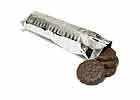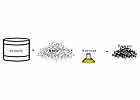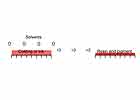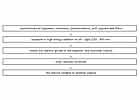
Laminating
adhesives require good adhesion onto the printing ink, the substrate and the laminating
foil, combined with low viscosity and good reactivity.
The application of ultraviolet light (UV)- and electron beam (EB)-curable systems has expanded far beyond the older, more established graphic arts and wood coatings. Although these applications still represent the largest volumes for UV/EB products, energy-curing technology has successfully entered new application areas that include the following.
- Adhesives
- Printing inks and varnishes
- Electronic media
- Optical fiber coatings
- Coatings for wood, paper/board and plastics
- Dental composites
- Release coatings (i.e., labels)
- Printed circuit boards
Laminating Adhesives
Laminating adhesives require good adhesion onto the printing ink, the substrate and the laminating foil, combined with low viscosity and good reactivity. Carefully formulated products based on oligomers and monomers with low shrinkage are available for sheet and web applications.Printing Inks
UV/EB curable inks are commercially available for most printing methods like screen, letterpress, flexo, inkjet and lithographic printing. The print quality is often higher compared to conventional inks. Most common substrates can be printed with radiation-curable inks: paper/board; labels; glass and plastic bottles; display and packaging materials; plastic foils; CDs; optical fibers; and metals.Varnishes
UV/EB varnishes are available for most application methods. The varnish protects the print and substrate, and the gloss level can be matte or very high.Wood Coatings
UV-curable systems for wood coatings are used for many applications and products. Common methods of application are by roll coater, spray, casting and vacuum coater. Filler, basecoat, clear and pigmented topcoat are all used for kitchen or office furniture, chairs, parquet floor, decorative parts in cars, panels, etc.Coatings for Plastics
Like wood, coatings for plastics can be applied by most common methods. The coatings will protect the plastic from damage, such as abrasion and scratching or staining. Applications include vinyl flooring, helmets, lenses, headlights for cars, skis and snowboards, tennis rackets, golf balls, packaging, CDs, and DVDs.Coatings for Electronics
In the manufacturing of printed circuit boards, UV-curable systems are essential. Solder masks and etch resists are the most common products. Many other, more specific applications are used in this field, including adhesives, marking inks, topcoats, potting compounds, conductive inks and dielectric coatings.
Figure 1. Composition of Conventional Coatings and Inks
Composition of Conventional Coatings and Inks
Coatings are normally clear transparent films that are designed to protect the substrate. The surface appearance can be controlled from matte to high gloss. Inks and paints have a similar composition, but also contain pigments and fillers.Solvents used in conventional inks and coatings are volatile organic compounds (VOCs) and are mainly used to reduce viscosity to correct levels depending on the required application method. Liquid inks or coatings with low viscosity (such those that are spray applied) contain more solvents than a paste ink.

Figure 2. Physical Drying of an Ink or Coating
Solvent-Based Inks and Coatings
The solvents used here are typically alcohols or petroleum-based distillation products. Besides viscosity reduction, solvents are used to control the time for flow out, gloss and the time for the physical drying process. Solvents evaporate after the coating is applied onto the substrate and leave a thin homogenous film of solid resin binder and pigments.An ink or coating may contain up to 70% volatile organic solvents, which evaporate during the drying process and are not present in the final coating. Increased awareness of the environmental impact of VOCs has led to a reduction in the solvent content of these coatings and inks. Other concerns with solvents are flammability and risk to health by inhalation.
Water-Based Inks and Coatings
Water-based inks and coatings are widely used to overcome the environmental issues and handling of solvent-based materials. The advantage is obvious - water is used instead of flammable organic solvents to reduce the ink or coating’s viscosity. Although this is the same drying process that is used for solvent-based coatings, the slow evaporation rate of water decreases productivity and increases energy consumption of the process. Most waterbased inks and coatings are not entirely free of VOCs; they often contain small amounts of solvents to improve stability, compatibility, and film-forming properties.Powder Coatings
These solvent-free fine powders are a mixture of solid resin, pigment and a solid hardener. The coating is heated after being applied to the substrate. The powder melts and cures under heat and forms a film with good resistance to solvents and impact. Due to their excellent properties, powder coatings are used in high-performance applications. The required high temperature (>100°C) limits the application of powder coatings mainly to metals.Other Reactive Inks and Coatings
Other reactive inks and coatings consist of semisolid or liquid resins with chemical unsaturation or reactive groups, such as unsaturated polyester, epoxy, or polyurethane resins. A second component - either a hardener or catalyst - is mixed to the coating just before the application. The polymerization reaction starts and the liquid coating is transformed to a solid film. The chemical reaction provides a polymer film with excellent properties and resistance to chemicals and other effects. Based on their application and other requirements, these inks and coatings may contain VOCs or water in order to adjust viscosity.Radiation-Curable Inks and Coatings
Radiation-curable inks and coatings are also chemically cured systems. In the case of UV-curable systems, the catalyst is a photoinitiator. After the coating is applied to the substrate, it is exposed to UV light, and this initiates polymerization. Without UV light exposure, the coating remains liquid.Basics for UV/EB Systems
The main resins used to produce radiation formulations contain chemically reactive groups. These mostly liquid or semisolid resins will polymerize upon exposure to high-energy radiation or as a reaction with the breakdown products of the photoactive compound (photoinitiator). This initiates a chain reaction that will transform the liquid resin into a solid plastic. This process, called polymerization, offers solvent-free application of a liquid and low-viscosity coating or ink that cures in a fraction of a second. These cured films typically show excellent gloss and resistance to chemicals, scratch or abrasion.
Figure 3. Polymerization
Polymerization
- Liquid mixture of oligomers, monomers, photoinitiators, pigment and fillers
- Exposure to high-energy radiation or UV light (220-400 nm)
- Initiate the reactive groups of the oligomer and monomer mixture
- Chain reaction continues
- The mixture hardens to a tack-free coating
- With some exceptions, these systems do not contain VOCs and will not pollute the environment.
Radically Curable Systems
The chemistry of radiation-curable adhesives, coatings or inks can be divided into free-radical and cationic-curable systems. While some applications use unsaturated polyester/styrene systems, acrylate terminated resins (oligomers) and diluents (monomers) are the class of materials mainly used for the formulation of UV- or EB-curable materials. Resins with methacrylate, vinyl ether or maleate functionality are used to a lesser extent in more specific applications.UV Curing
The UV-curing process is as follows.- Radiation in the range of 200-400 nm is emitted by a UV light source, normally a medium-pressure mercury bulb. The photoinitiator absorbs the emitted light and photolyzes into highly reactive free radicals.
- Free radicals add to the double bonds of the oligomer and monomer mixture and initiate a chain reaction.
- The chain reaction builds up a network with the polymerized oligomers and monomers. The flexibility of the growing molecules decreases with time and will finally stop the chain reaction. The coating has turned from liquid to solid.
- Post (exposure) curing (approx. 24 hours) is not visible but may have an impact on the final properties, such as adhesion or flexibility.
A typical composition of a UV-curable ink or coating:
Resins (oligomers) 30-60%
Reactive diluents (monomers) 5-50%
Pigments, fillers, matting agents 0-40%
Photoinitiators, synergists 2-15%
Additives 1-5%
Electron-Beam Curing
The main steps in the polymerization reaction are as follows.- Low voltage electron beams are produced with a cathode and accelerated. The electrons are bombarded onto the substrate and coating, adding to the double bonds to form primary radical species.
- These radicals will react with other double bonds and the chain reaction is initiated.
- The chain reaction builds up a network with the polymerized oligomers and monomers. The flexibility of the growing molecules decreases with time and will finally stop the chain reaction. The coating has turned from liquid to solid.
As oxygen inhibits the polymerization reaction, the electron beam curing process operates under inert atmosphere using nitrogen. The high initial investment and ongoing cost to run an electron beam curing (EBC) operation limits the technology to high volume production or those applications where the EBC features are essential.
Cationic-Curable Systems
The composition of a cationically curable system is comparable to radical systems. The photoinitiator, orphotocatalyst (often a triarylsulfonium salt), photolyzes into a super acid, which catalyzes the polymerization reaction. The primary binders used are cycloaliphatic epoxy resins, polyols and other epoxy or vinyl ether functionalized low-viscosity resins. For specific applications, these systems may show better adhesion or barrier properties. Contrary to free-radical-curable systems, the cure of such inks and coatings is not inhibited by oxygen, but high humidity can affect the reaction. The super acid catalyst can also be neutralized by basic substrates or substrates that have been treated with basic materials and result in slow or no curing. The post-curing effect of cationic-curable inks and coatings is significant and will accelerate at elevated temperatures. Cationic systems could be used in most applications, following the above criteria.Hybrid-Curable Systems
Hybrid-curable systems are mixtures of radical and cationic curable raw materials (acrylate/vinyl ether; epoxy/acrylate; maleate/vinyl ether, etc.). For specific applications and requirements, the hybrid curable system’s combined features may offer a solution.Formulation Suggestions
The final properties of a cured adhesive, coating or ink are dominated by the monomers and oligomers used in the formulation. The type of oligomer or oligomer mixture defines the flexibility, hardness and resistance to chemicals or weathering of the final, cured product. Monomers are used to adjust the viscosity required by the application. Depending on the monomer’s functionality, they can also increase the hardness and the crosslinking density of the cured film. Some monomers also act as excellent solvents for plastic substrates and can increase adhesion to these materials. In adhesives, composites and similar applications, methacrylates are preferred due to less shrinkage and, in general, less irritation. For inks and coatings, acrylate-terminated resins and diluents are widely used due to their higher reactivity.For more information, visit www.rahn-group.com.